Related Research Articles
"United Republic", also known by its incipit as "Repeat, O World, my song", is the national anthem of Yemen. It was written by Abdullah Noman and composed by Ayoob Tarish. It was formerly used as the national anthem of South Yemen but was adopted by Yemen when the country was unified in 1990.
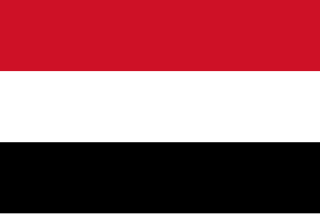
Yemen, officially the Republic of Yemen, is a country in West Asia. It is located in the southern end of the Arabian Peninsula, bordering Saudi Arabia to the north and Oman to the northeast. It shares maritime borders with Eritrea, Djibouti and Somalia. Covering 530,000 square kilometres and having a coastline of approximately 2,000 kilometres, Yemen is the second-largest Arab sovereign state on the Arabian Peninsula. Sanaa is its constitutionally stated capital and largest city. The country's population is estimated to be 34.7 million as of 2023. Yemen is a member of the Arab League, the United Nations, the Non-Aligned Movement and the Organisation of Islamic Cooperation.

The State flag of Yemen was adopted on May 22, 1990, the day that North Yemen and South Yemen were unified. The flag of Yemen is basically the Arab Liberation Flag of 1952, introduced after the Egyptian Revolution of 1952 in which Arab nationalism was a dominant theme. The Arab Liberation Flag of 1952 served as the inspiration for the flags of both North and South Yemen prior to unification, as well as for the current flags of Egypt, Iraq, Sudan, Palestine and Syria.

The Yemen Arab Republic, commonly known as North Yemen or Yemen (Sanaʽa), was a country that existed from 1962 to 1990 in the northwestern part of what is now Yemen. Its capital was at Sanaa. It united with the People's Democratic Republic of Yemen on 22 May 1990 to form the current Republic of Yemen.

South Yemen, officially the People's Democratic Republic of Yemen, was a state that existed from 1967 to 1990 as the only communist state in the Middle East and the Arab world. It was made up of the southern and eastern Governorates of the present-day Republic of Yemen, including the island of Socotra. It was bordered by North Yemen to the North-West, Saudi Arabia to the North, and Oman to the East.
Haidar Abu Bakr al-Attas was appointed Prime Minister of Yemen by President Ali Abdullah Saleh when the People's Democratic Republic of Yemen and Yemen Arab Republic united in 1990 to form present-day Yemen. Al-Attas served until 1994. He is a member of the Yemeni Socialist Party.
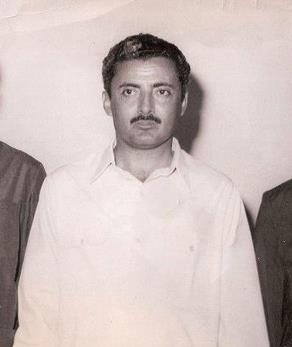
Salem Rubai Ali, known by his comrades as Salemeen, was the Marxist head of state of the People's Democratic Republic of Yemen from 22 June 1969 until his execution on 26 June 1978.

The Democratic Republic of Yemen, colloquially known as South Yemen, was a breakaway state that fought against the main land of Yemen in the 1994 Yemeni Civil War. It was declared in May 1994 and covered all of the former South Yemen.
The Yemen Times was an independent English-language newspaper in Yemen. The paper was published twice weekly.

The rial is the official currency of the Republic of Yemen. It is technically divided into 100 fils, although coins denominated in fils have not been issued since Yemeni unification. Due to the ongoing political instability, the value of the Yemeni rial has fallen significantly.

South Arabia is a historical region that consists of the southern region of the Arabian Peninsula in Western Asia, mainly centered in what is now the Republic of Yemen, yet it has also historically included Najran, Jizan, Al-Bahah, and 'Asir, which are presently in Saudi Arabia, and the Dhofar of present-day Oman.

The Yemeni Socialist Party is a political party in Yemen. A successor of Yemen's National Liberation Front, it was the ruling party in South Yemen until Yemeni unification in 1990. Originally Marxist–Leninist, the party has gradually evolved into a social democratic opposition party in today's unified Yemen.
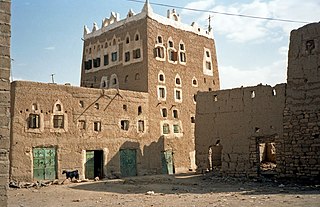
Saada, a city and ancient capital in the northwest of Yemen, is the capital and largest city of the province of the same name, and the county seat of the county of the same name. The city is located in the mountains of Serat (Sarawat) at an altitude of about 1,800 meters and had an estimated population of 51,870 in 2004, when it was the tenth largest city in Yemen.
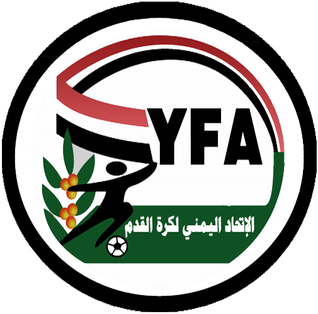
The Yemen Football Association is the governing body of football in Yemen. The organisation joined FIFA in 1980 as the Yemen Arab Republic, and was later united with People's Republic of South Yemen in 1990

Yemeni unification took place on May 22, 1990, when the People's Democratic Republic of Yemen was united with the Yemen Arab Republic, forming the Republic of Yemen.
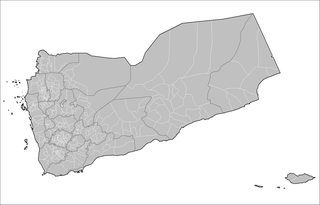
The administrative division of Yemen consists of two main divisions. There are 22 governorates, including the capital Sana'a and Socotra Archipelago. The 22 governorates are then divided into 333 districts, subdivided into 2,210 sub-districts, and then into 38,284 villages.
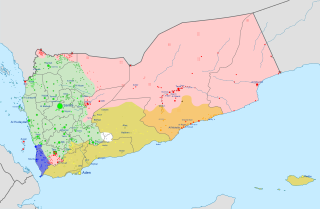
Lesbian, gay, bisexual, transgender (LGBT) people in Yemen face severe challenges not experienced by non-LGBT residents. Same-sex adultery is punishable by death. Members of the LGBT community additionally face stigmatization among the broader population.
Jumhūriyyah is the word for "republic" in the Arabic language. Loanwords representing variations of the term also exist in other language families, especially Turkic.

The Arab League has 22 member states. It was founded in Cairo in March 1945 with six members: the Kingdom of Egypt, Kingdom of Iraq, Lebanon, Saudi Arabia, Syrian Republic, and Transjordan. North Yemen joined on 5 May 1945. Membership increased during the second half of the 20th century. Seven countries have observer status. The headquarters are located in Cairo, Egypt.
References
- ↑ YEMEN (PEOPLE'S DEMOCRATIC REPUBLIC) CRL Foreign Official Gazette Database, 2014. Retrieved 3 September 2014. Archived here.